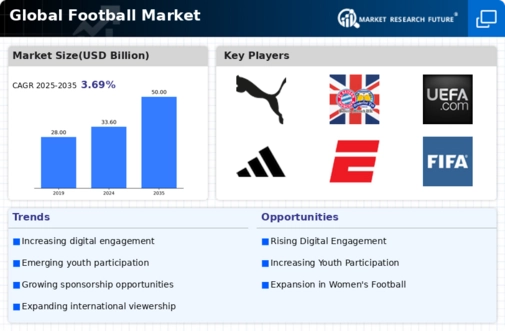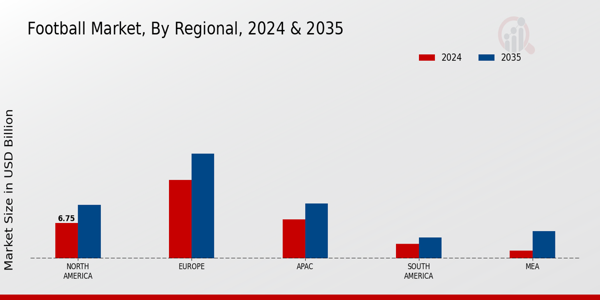- Football Market By Product Type (USD Billion, 2019-2035)
- Football
- Training Equipment
- Protective Gear
- Accessories
- Football Market By Distribution Channel (USD Billion, 2019-2035)
- Online Retail
- Offline Retail
- Sports Stores
- Football Market By End User (USD Billion, 2019-2035)
- Professional Players
- Amateur Players
- Coaches
- Teams
- Football Market By Event Type (USD Billion, 2019-2035)
- Domestic Leagues
- International Tournaments
- Friendly Matches
- Football Market By Regional (USD Billion, 2019-2035)
- North America
- Europe
- South America
- Asia Pacific
- Middle East and Africa
North America Outlook (USD Billion, 2019-2035)
North America Football Market by Product Type
Football
Training Equipment
Protective Gear
Accessories
North America Football Market by Distribution Channel Type
Online Retail
Offline Retail
Sports Stores
North America Football Market by End User Type
Professional Players
Amateur Players
Coaches
Teams
North America Football Market by Event Type
Domestic Leagues
International Tournaments
Friendly Matches
North America Football Market by Regional Type
US
Canada
US Outlook (USD Billion, 2019-2035)
US Football Market by Product Type
Football
Training Equipment
Protective Gear
Accessories
US Football Market by Distribution Channel Type
Online Retail
Offline Retail
Sports Stores
US Football Market by End User Type
Professional Players
Amateur Players
Coaches
Teams
US Football Market by Event Type
Domestic Leagues
International Tournaments
Friendly Matches
CANADA Outlook (USD Billion, 2019-2035)
CANADA Football Market by Product Type
Football
Training Equipment
Protective Gear
Accessories
CANADA Football Market by Distribution Channel Type
Online Retail
Offline Retail
Sports Stores
CANADA Football Market by End User Type
Professional Players
Amateur Players
Coaches
Teams
CANADA Football Market by Event Type
Domestic Leagues
International Tournaments
Friendly Matches
Europe Outlook (USD Billion, 2019-2035)
Europe Football Market by Product Type
Football
Training Equipment
Protective Gear
Accessories
Europe Football Market by Distribution Channel Type
Online Retail
Offline Retail
Sports Stores
Europe Football Market by End User Type
Professional Players
Amateur Players
Coaches
Teams
Europe Football Market by Event Type
Domestic Leagues
International Tournaments
Friendly Matches
Europe Football Market by Regional Type
Germany
UK
France
Russia
Italy
Spain
Rest of Europe
GERMANY Outlook (USD Billion, 2019-2035)
GERMANY Football Market by Product Type
Football
Training Equipment
Protective Gear
Accessories
GERMANY Football Market by Distribution Channel Type
Online Retail
Offline Retail
Sports Stores
GERMANY Football Market by End User Type
Professional Players
Amateur Players
Coaches
Teams
GERMANY Football Market by Event Type
Domestic Leagues
International Tournaments
Friendly Matches
UK Outlook (USD Billion, 2019-2035)
UK Football Market by Product Type
Football
Training Equipment
Protective Gear
Accessories
UK Football Market by Distribution Channel Type
Online Retail
Offline Retail
Sports Stores
UK Football Market by End User Type
Professional Players
Amateur Players
Coaches
Teams
UK Football Market by Event Type
Domestic Leagues
International Tournaments
Friendly Matches
FRANCE Outlook (USD Billion, 2019-2035)
FRANCE Football Market by Product Type
Football
Training Equipment
Protective Gear
Accessories
FRANCE Football Market by Distribution Channel Type
Online Retail
Offline Retail
Sports Stores
FRANCE Football Market by End User Type
Professional Players
Amateur Players
Coaches
Teams
FRANCE Football Market by Event Type
Domestic Leagues
International Tournaments
Friendly Matches
RUSSIA Outlook (USD Billion, 2019-2035)
RUSSIA Football Market by Product Type
Football
Training Equipment
Protective Gear
Accessories
RUSSIA Football Market by Distribution Channel Type
Online Retail
Offline Retail
Sports Stores
RUSSIA Football Market by End User Type
Professional Players
Amateur Players
Coaches
Teams
RUSSIA Football Market by Event Type
Domestic Leagues
International Tournaments
Friendly Matches
ITALY Outlook (USD Billion, 2019-2035)
ITALY Football Market by Product Type
Football
Training Equipment
Protective Gear
Accessories
ITALY Football Market by Distribution Channel Type
Online Retail
Offline Retail
Sports Stores
ITALY Football Market by End User Type
Professional Players
Amateur Players
Coaches
Teams
ITALY Football Market by Event Type
Domestic Leagues
International Tournaments
Friendly Matches
SPAIN Outlook (USD Billion, 2019-2035)
SPAIN Football Market by Product Type
Football
Training Equipment
Protective Gear
Accessories
SPAIN Football Market by Distribution Channel Type
Online Retail
Offline Retail
Sports Stores
SPAIN Football Market by End User Type
Professional Players
Amateur Players
Coaches
Teams
SPAIN Football Market by Event Type
Domestic Leagues
International Tournaments
Friendly Matches
REST OF EUROPE Outlook (USD Billion, 2019-2035)
REST OF EUROPE Football Market by Product Type
Football
Training Equipment
Protective Gear
Accessories
REST OF EUROPE Football Market by Distribution Channel Type
Online Retail
Offline Retail
Sports Stores
REST OF EUROPE Football Market by End User Type
Professional Players
Amateur Players
Coaches
Teams
REST OF EUROPE Football Market by Event Type
Domestic Leagues
International Tournaments
Friendly Matches
APAC Outlook (USD Billion, 2019-2035)
APAC Football Market by Product Type
Football
Training Equipment
Protective Gear
Accessories
APAC Football Market by Distribution Channel Type
Online Retail
Offline Retail
Sports Stores
APAC Football Market by End User Type
Professional Players
Amateur Players
Coaches
Teams
APAC Football Market by Event Type
Domestic Leagues
International Tournaments
Friendly Matches
APAC Football Market by Regional Type
China
India
Japan
South Korea
Malaysia
Thailand
Indonesia
Rest of APAC
CHINA Outlook (USD Billion, 2019-2035)
CHINA Football Market by Product Type
Football
Training Equipment
Protective Gear
Accessories
CHINA Football Market by Distribution Channel Type
Online Retail
Offline Retail
Sports Stores
CHINA Football Market by End User Type
Professional Players
Amateur Players
Coaches
Teams
CHINA Football Market by Event Type
Domestic Leagues
International Tournaments
Friendly Matches
INDIA Outlook (USD Billion, 2019-2035)
INDIA Football Market by Product Type
Football
Training Equipment
Protective Gear
Accessories
INDIA Football Market by Distribution Channel Type
Online Retail
Offline Retail
Sports Stores
INDIA Football Market by End User Type
Professional Players
Amateur Players
Coaches
Teams
INDIA Football Market by Event Type
Domestic Leagues
International Tournaments
Friendly Matches
JAPAN Outlook (USD Billion, 2019-2035)
JAPAN Football Market by Product Type
Football
Training Equipment
Protective Gear
Accessories
JAPAN Football Market by Distribution Channel Type
Online Retail
Offline Retail
Sports Stores
JAPAN Football Market by End User Type
Professional Players
Amateur Players
Coaches
Teams
JAPAN Football Market by Event Type
Domestic Leagues
International Tournaments
Friendly Matches
SOUTH KOREA Outlook (USD Billion, 2019-2035)
SOUTH KOREA Football Market by Product Type
Football
Training Equipment
Protective Gear
Accessories
SOUTH KOREA Football Market by Distribution Channel Type
Online Retail
Offline Retail
Sports Stores
SOUTH KOREA Football Market by End User Type
Professional Players
Amateur Players
Coaches
Teams
SOUTH KOREA Football Market by Event Type
Domestic Leagues
International Tournaments
Friendly Matches
MALAYSIA Outlook (USD Billion, 2019-2035)
MALAYSIA Football Market by Product Type
Football
Training Equipment
Protective Gear
Accessories
MALAYSIA Football Market by Distribution Channel Type
Online Retail
Offline Retail
Sports Stores
MALAYSIA Football Market by End User Type
Professional Players
Amateur Players
Coaches
Teams
MALAYSIA Football Market by Event Type
Domestic Leagues
International Tournaments
Friendly Matches
THAILAND Outlook (USD Billion, 2019-2035)
THAILAND Football Market by Product Type
Football
Training Equipment
Protective Gear
Accessories
THAILAND Football Market by Distribution Channel Type
Online Retail
Offline Retail
Sports Stores
THAILAND Football Market by End User Type
Professional Players
Amateur Players
Coaches
Teams
THAILAND Football Market by Event Type
Domestic Leagues
International Tournaments
Friendly Matches
INDONESIA Outlook (USD Billion, 2019-2035)
INDONESIA Football Market by Product Type
Football
Training Equipment
Protective Gear
Accessories
INDONESIA Football Market by Distribution Channel Type
Online Retail
Offline Retail
Sports Stores
INDONESIA Football Market by End User Type
Professional Players
Amateur Players
Coaches
Teams
INDONESIA Football Market by Event Type
Domestic Leagues
International Tournaments
Friendly Matches
REST OF APAC Outlook (USD Billion, 2019-2035)
REST OF APAC Football Market by Product Type
Football
Training Equipment
Protective Gear
Accessories
REST OF APAC Football Market by Distribution Channel Type
Online Retail
Offline Retail
Sports Stores
REST OF APAC Football Market by End User Type
Professional Players
Amateur Players
Coaches
Teams
REST OF APAC Football Market by Event Type
Domestic Leagues
International Tournaments
Friendly Matches
South America Outlook (USD Billion, 2019-2035)
South America Football Market by Product Type
Football
Training Equipment
Protective Gear
Accessories
South America Football Market by Distribution Channel Type
Online Retail
Offline Retail
Sports Stores
South America Football Market by End User Type
Professional Players
Amateur Players
Coaches
Teams
South America Football Market by Event Type
Domestic Leagues
International Tournaments
Friendly Matches
South America Football Market by Regional Type
Brazil
Mexico
Argentina
Rest of South America
BRAZIL Outlook (USD Billion, 2019-2035)
BRAZIL Football Market by Product Type
Football
Training Equipment
Protective Gear
Accessories
BRAZIL Football Market by Distribution Channel Type
Online Retail
Offline Retail
Sports Stores
BRAZIL Football Market by End User Type
Professional Players
Amateur Players
Coaches
Teams
BRAZIL Football Market by Event Type
Domestic Leagues
International Tournaments
Friendly Matches
MEXICO Outlook (USD Billion, 2019-2035)
MEXICO Football Market by Product Type
Football
Training Equipment
Protective Gear
Accessories
MEXICO Football Market by Distribution Channel Type
Online Retail
Offline Retail
Sports Stores
MEXICO Football Market by End User Type
Professional Players
Amateur Players
Coaches
Teams
MEXICO Football Market by Event Type
Domestic Leagues
International Tournaments
Friendly Matches
ARGENTINA Outlook (USD Billion, 2019-2035)
ARGENTINA Football Market by Product Type
Football
Training Equipment
Protective Gear
Accessories
ARGENTINA Football Market by Distribution Channel Type
Online Retail
Offline Retail
Sports Stores
ARGENTINA Football Market by End User Type
Professional Players
Amateur Players
Coaches
Teams
ARGENTINA Football Market by Event Type
Domestic Leagues
International Tournaments
Friendly Matches
REST OF SOUTH AMERICA Outlook (USD Billion, 2019-2035)
REST OF SOUTH AMERICA Football Market by Product Type
Football
Training Equipment
Protective Gear
Accessories
REST OF SOUTH AMERICA Football Market by Distribution Channel Type
Online Retail
Offline Retail
Sports Stores
REST OF SOUTH AMERICA Football Market by End User Type
Professional Players
Amateur Players
Coaches
Teams
REST OF SOUTH AMERICA Football Market by Event Type
Domestic Leagues
International Tournaments
Friendly Matches
MEA Outlook (USD Billion, 2019-2035)
MEA Football Market by Product Type
Football
Training Equipment
Protective Gear
Accessories
MEA Football Market by Distribution Channel Type
Online Retail
Offline Retail
Sports Stores
MEA Football Market by End User Type
Professional Players
Amateur Players
Coaches
Teams
MEA Football Market by Event Type
Domestic Leagues
International Tournaments
Friendly Matches
MEA Football Market by Regional Type
GCC Countries
South Africa
Rest of MEA
GCC COUNTRIES Outlook (USD Billion, 2019-2035)
GCC COUNTRIES Football Market by Product Type
Football
Training Equipment
Protective Gear
Accessories
GCC COUNTRIES Football Market by Distribution Channel Type
Online Retail
Offline Retail
Sports Stores
GCC COUNTRIES Football Market by End User Type
Professional Players
Amateur Players
Coaches
Teams
GCC COUNTRIES Football Market by Event Type
Domestic Leagues
International Tournaments
Friendly Matches
SOUTH AFRICA Outlook (USD Billion, 2019-2035)
SOUTH AFRICA Football Market by Product Type
Football
Training Equipment
Protective Gear
Accessories
SOUTH AFRICA Football Market by Distribution Channel Type
Online Retail
Offline Retail
Sports Stores
SOUTH AFRICA Football Market by End User Type
Professional Players
Amateur Players
Coaches
Teams
SOUTH AFRICA Football Market by Event Type
Domestic Leagues
International Tournaments
Friendly Matches
REST OF MEA Outlook (USD Billion, 2019-2035)
REST OF MEA Football Market by Product Type
Football
Training Equipment
Protective Gear
Accessories
REST OF MEA Football Market by Distribution Channel Type
Online Retail
Offline Retail
Sports Stores
REST OF MEA Football Market by End User Type
Professional Players
Amateur Players
Coaches
Teams
REST OF MEA Football Market by Event Type
Domestic Leagues
International Tournaments
Friendly Matches















Leave a Comment